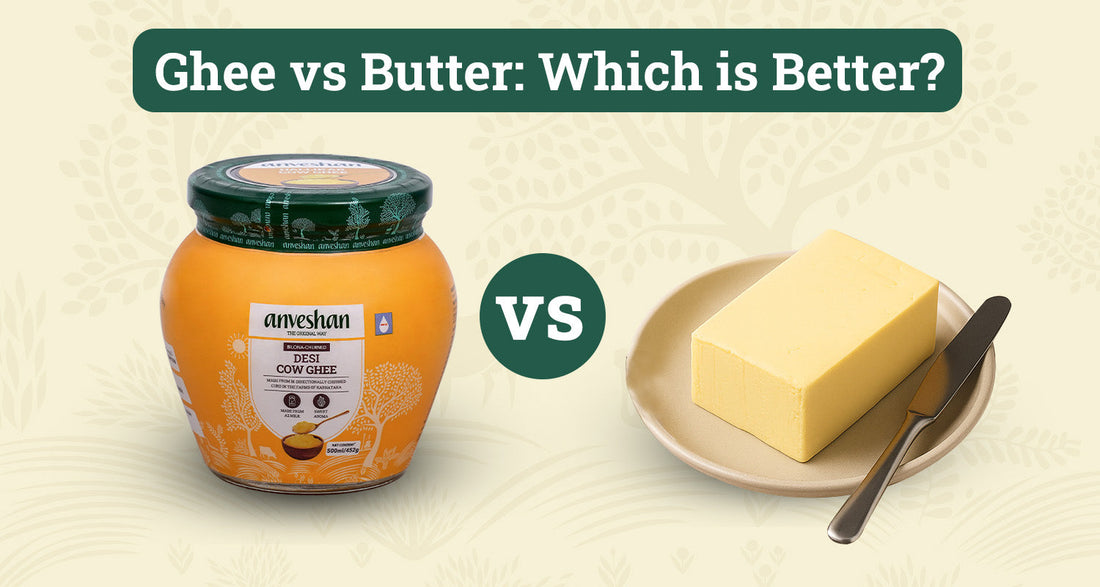
Butter vs Desi Ghee: Which One is Better for You?
Share
One of the most heated debates in the Indian kitchen is butter and desi ghee difference. Butter, loved in the West, brings creamy richness to breads and desserts. Ghee, treasured in India, is praised not only for flavour but also for its Ayurvedic benefits. Both come from milk, but their preparation, nutrition, and health effects are worlds apart.
What Is Butter?
Butter is made by churning cream until milk fat separates from liquid buttermilk. It is soft, creamy, and a favourite for baking and spreading.
-
Fat Content: ~80% fat, rest is water and milk solids
-
Nutrition: Provides vitamin A, small amounts of D, E, K
-
Smoke Point: ~350°F (177°C) good for sautéing, not for frying
-
Taste: Creamy, mild, slightly sweet
-
Storage: Needs refrigeration, short shelf life
-
Note: Contains lactose and casein, may cause discomfort for lactose-intolerant people
What Is Ghee?
Ghee is clarified butter. First, cream is turned into curd and then churned slowly (traditionally in a bilona) and then converted to butter. After that the butter is cooked until all water evaporates and milk solids are removed. It is golden, aromatic, and nutrient-rich.
-
Fat Content: Almost 100% pure fat
-
Nutrition: High in vitamins A, D, E, K, plus CLA and Butyrate
-
Smoke Point: ~450–485°F (232–252°C) stable for deep frying
-
Taste: Rich, golden, daanedaar, aromatic enhances Indian curries and tadka
-
Storage: Stays fresh for months without refrigeration
-
Note: Lactose and casein free—safe for dairy-sensitive people
Butter and Ghee Nutrition Comparison
|
Aspect |
Butter (per tbsp) |
Ghee (per tbsp) |
|
Calories |
~102 kcal |
~120–130 kcal |
|
Total Fat |
~11.5 g |
~14 g |
|
Saturated Fat |
~7 g |
~9–10 g |
|
Cholesterol |
~31 mg |
~33 mg |
|
Smoke Point |
~350°F |
~450–485°F |
|
Lactose/Casein |
Present |
Absent |
|
Shelf Life |
Short, refrigerated |
Long, room temp |
Ghee or Butter, Which Is Better?
-
For High-Heat Cooking: Ghee wins because of its higher smoke point.
-
For Baking: Butter is better, it gives cakes and cookies their soft texture.
-
For Dairy-Sensitive People: Ghee is safer since it has no lactose or casein.
-
For Flavour: Butter is creamy, while ghee adds a richness to Indian dishes.
Traditional Uses of Butter and Ghee
-
Butter: A classic in Europe and America for bread, sauces, pastries, and desserts.
-
Ghee: Central to Indian traditions. Used in pujas, Ayurveda therapies, and daily cooking. Ayurveda describes ghee as a rasayana, a rejuvenator that supports digestion, skin health, and immunity.
Which Has Better Fats?
-
Butter: High in saturated fat, linked with higher LDL cholesterol if consumed in excess.
-
Ghee: Also rich in saturated fat but contains short-chain fatty acids like Butyrate and CLA, which support gut health and may reduce inflammation.
Nutrients in Butter and Ghee
-
Butter: Contains vitamin A and small amounts of other fat-soluble vitamins.
-
Ghee: Denser in nutrients because it is pure fat, richer in vitamins A, D, E, K and antioxidants.
Shelf Life and Storage
-
Butter: Spoils faster due to water and milk solids; needs refrigeration.
-
Ghee: Naturally preserved by clarification, stays good at room temperature for months.
Cooking Applications
-
Butter: Ideal for baking, pancakes, cookies, and creamy sauces.
-
Ghee: Perfect for curries, dal tadka, frying, and brushing on rotis. Its stability at high heat makes it a healthier cooking fat.
Anveshan desi ghee, is the real desi ghee. Made using curd, not cream, it is great for your gut, boosts immunity, digestive powers and is clearly the better alternative to mass-produced and ultra-processed butter.












 You saved ₹-48 on this order
You saved ₹-48 on this order
